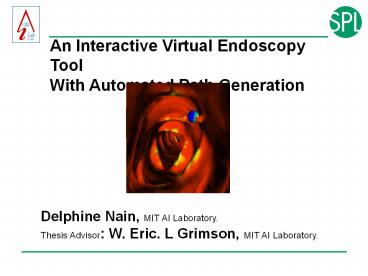An%20Interactive%20Virtual%20Endoscopy%20Tool - PowerPoint PPT Presentation
Title:
An%20Interactive%20Virtual%20Endoscopy%20Tool
Description:
lower resolution than video. Segmentation: Volume. 3D ... Virtual Colonoscopy. System Requirements. Combination of Interactivity and Automation is key ... – PowerPoint PPT presentation
Number of Views:241
Avg rating:3.0/5.0
Title: An%20Interactive%20Virtual%20Endoscopy%20Tool
1
An Interactive Virtual Endoscopy Tool With
Automated Path Generation
Delphine Nain, MIT AI Laboratory. Thesis Advisor
W. Eric. L Grimson, MIT AI Laboratory.
2
Presentation Overview
- Background and Motivation
- Interactive System
- Central Path Planning Algorithm
- Synchronized Virtual Endoscopy
- Conclusion
3
Medical Motivation
- Cancer is the 2nd cause of death in the US
- 43 of people have a risk to be diagnosed with
cancer - Out of those 88 are cancer in inner organ
- How can see inside the body to
- screen and cure?
4
Conventional Endoscopy
- advantages
- minimally invasive
- high resolution
- interactivity
- disadvantages
- can be painful and uncomfortable
- limited exploration
5
Conventional Medical Imaging
6
Conventional Visualization
- advantages
- non invasive
- information on tissue shape through and beyond
walls of organ
- disadvantages
- mentally align contiguous slides
- lower resolution than video
7
Segmentation Volume
8
3D Reconstruction Model
9
3D Visualization
10
Virtual Endoscopy
- Combines strengths of previous alternatives on
patient-specific dataset - Spatial exploration
- Cross-correlation with original
- volume
Compact and Intuitive way to explore huge amount
of information
11
Virtual Endoscopy advantages
- clinical studies
- planning and post-operation generates views that
are not observable in actual endoscopic
examinations - color coding algorithms give supplemental
information
12
Virtual Colonoscopy
13
System Requirements
- Combination of Interactivity and Automation is
key - Cross Reference between 3D models and grayscale
volumes
14
Presentation Overview
- Background and Motivation
- Interactive System
- Central Path Planning Algorithm
- Synchronized Virtual Endoscopy
- Conclusion
15
Display
16
Navigation Interface
17
Cross Reference
Provided by Arjan Welmers
18
Path Update
19
Applications Middle Ear
Thomas Rodt Soenke Bartling
20
Applications Cardiovascular
Provided by Bonglin Chung
21
Presentation Overview
- Background and Motivation
- Interactive System
- Central Path Planning Algorithm
- Synchronized Virtual Endoscopy
- Conclusion
22
Automated Path Planning
- Goal
- provide a create path button that
- produces a centerline inside a 3D
- model of any topology
23
Input
24
Output
25
Step 1 Produce a Labelmap
26
Step 2 Produce a distance map
27
Step 3 Create a Graph
- Create a Graph description of the Distance Map
- Nodes are voxels inside the model
- Edge weight are 1/(distance)2 from the wall of
the organ
28
Step 4 Run modified Dijkstra
- Dijkstra algorithm is a single source
- shortest path algorithm
- We use a binary heap
- An optimization keep an evolving front, stop
when reach the end node
29
Step 5 Results
Running Time 7s
30
Step 5 Results
Running Time 3s
31
Presentation Overview
- Background and Motivation
- Interactive System
- Central Path Planning Algorithm
- Synchronized Virtual Endoscopy
- Conclusion
32
Synchronized Virtual Colonoscopy
33
Dynamic Programming
34
Results
35
Conclusion
- Combination of Automation and Interactivity is
key - Cross Reference is important
- Synchronized Fly-Throughs is
- novel contribution
- Publication D. Nain, S. Haker, E. Grimson, R.
Kikinis - An Interactive Virtual
Endoscopy Tool, - IMIVA workshop, MICCAI 2001.
36
Acknowledgements
- Ron Kikinis
- Steve Haker
- Lauren ODonnell
- David Gering
- Carl-Fredrik Westin
- Peter Everett
- Sandy Wells
- Eric Cosman
- Polina Golland
- Soenke Bartling
- John Fisher
- Mike Halle
- Ferenc Jolesz
37
Thank You!
Steve Haker, Hoon Ji, Connie Sehnert
38
Correspondance
VC
T is transformation matrix (translation or
rotation along local axis)
To uniquely determine the coordinates of the
virtual camera
- coordinates of camera
-
VCnew VCold T
- coordinates of the focal point
-
FPnew VCnew T
39
Cross Reference
Provided by Arjan Welmers
40
3D Visualization
41
Synchronized Virtual Endoscopy































